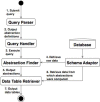Abstraction-based temporal data retrieval for a Clinical Data Repository
- PMID: 18693907
- PMCID: PMC2655874
Abstraction-based temporal data retrieval for a Clinical Data Repository
Abstract
Disease and patient care processes often create characteristic states, trends, and temporal patterns in clinical events and observations, called temporal abstractions. Identifying patient populations who share similar abstractions may be useful for clinical research, outcomes studies, and quality assurance. In these settings, abstractions may be specific to a query, and thus allowing the specification of abstractions directly in the query would be desirable. We propose a query language for specifying and retrieving clinical data sets that allows specifying abstractions directly, and automatically selects data for retrieval based on the presence of abstractions inferred from the data. We describe the language and a prototype implementation, demonstrate its features with two queries constructed in response to clinical researcher-initiated data requests submitted to our institution's Clinical Data Repository, and report preliminary results from an evaluation of the implementation's performance.
Figures


References
-
- Safran C, Chute CG. Exploration and exploitation of clinical databases. Int J Biomed Comput. 1995 Apr;39(1):151–6. - PubMed
-
- Shahar Y. Dimensions of time in illness: an objective view. Ann Intern Med. 2000 Jan 4;132(1):45–53. - PubMed
-
- Adlassnig KP, Combi C, Das AK, Keravnou ET, Pozzi G. Temporal representation and reasoning in medicine: research directions and challenges. Artif Intell Med. 2006 Oct;38(2):101–13. - PubMed
-
- Snodgrass R, Bohlen MH, Jensen CS, Steiner A. Transitioning temporal support in TSQL2 to SQL3. In: Etzion O, Jajodia S, Sripada S, editors. Temporal Databases: Research and Practice. Berlin, NY: Springer; 1998. pp. 150–94.
Publication types
MeSH terms
Grants and funding
LinkOut - more resources
Full Text Sources
